“In all of us there is a hunger, marrow-deep, to know our heritage, to know who we are and where we have come from..” – Alex Haley
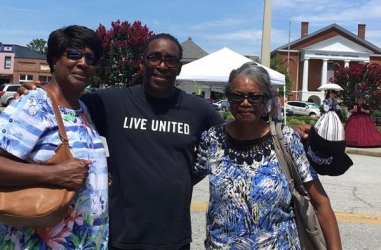
Local historian, Wayne O’Bryant set the tone for the first annual Dave Day. Written in bold white letters across his black tee-shirt was, “Live- United”. He said that he found the plea on the shirt to be fitting in light of our nations recent tragedies.
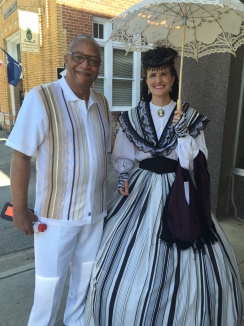
Tonya Guy & John, one of Dave’s family members.
This 100- degree- plus day in July would certainly prove to be a healing balm across two counties as Aiken and Edgefield, South Carolina, assembled to celebrate the life and legacy of the enslaved potter-poet, David Drake. It was a weekend-long event that brought people together to contemplate how, even in the throws of oppression, the spirit of one man could prevail.
Dave was an incredibly talented potter who wrote and signed insightful couplets on his stoneware jars. His words sometimes expressed his feelings or his faith but the most remarkable aspect of it all is that it was accomplished while he was bound by the chains of enslavement. Slave masters understood that knowledge was power. Virtually all slave codes established in the United States outlawed teaching slaves to read or write.
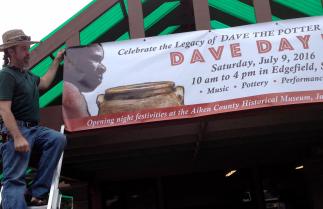 Dave made the proclamation of his resistance every time he signed his name.
Dave made the proclamation of his resistance every time he signed his name.
I, made this Jar, all of cross
If, you dont repent, you will be, lost
3 May 1862
Ramona Austin, scholar in African American Art, recently told me that Dave would have been seen by his community as a man of special talents, one who had powers. “He was someone to look up to…someone to be followed. Men like Dave help us understand how people survived.” (1)
Brenda Baratto, Director of the Aiken Historical Museum and Biographer, Leonard Todd are responsible for Dave’s recent induction into the South Carolina Hall of Fame this past April. This honor and recognition prompted a team of us to understand the need for a special day to celebrate the far-reaching and extraordinary power Dave still has on people today.
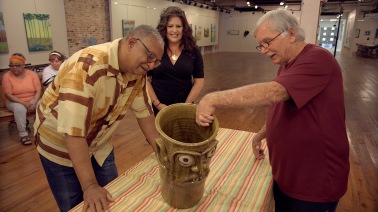
Potter, Gary Dexter presenting a face vessel to Dave’s family.
This sparked within me a curiosity to try and find Dave’s family. How could we celebrate this without them?
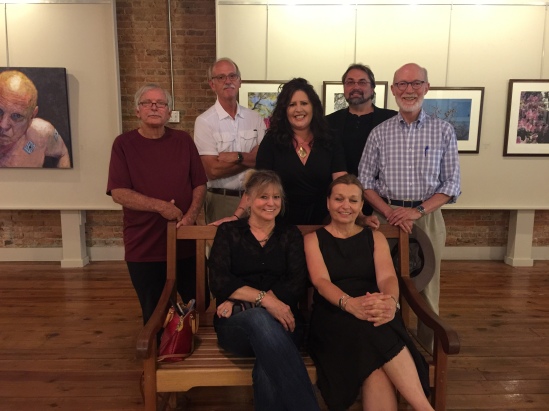
Top Row: Gary Dexter, Jamie Koelker, April Hynes, Buddy Wingard, Leonard Todd, Bottom Row: Christie Koelker & Brenda Baratto.
Leonard Todd’s thorough research into Dave’s life in “Carolina Clay, the Life and Legend of the Slave Potter, Dave”, recorded that Dave had lived from about 1801 until the mid 1870’s. He also noted that Dave’s family had yet to be located.
Faced with the difficult task of putting together Dave’s hypothetical family tree – Leonard wrote, “Perhaps a child of a child of a child of Dave will see this and bring long stored family memories to light ” Dave first appears in the records as the “undisputed possession” of Harvey Drake in a mortgage agreement dated June 13, 1818. (2)
Discovered by Jill Koverman, this document sheds light on Dave’s life by revealing he was “about 17 years old”. This would place his birth about 1801. It also indicates he was “country born,” meaning that he was born in America.
The death of Dave’s owner, Rev. John Landrum, on December 9, 1846, marked a terribly difficult moment in Dave’s life because shortly thereafter, he and those close to him were put up for sale. Dave was at the top of a list of eighteen men, woman and children. (3)
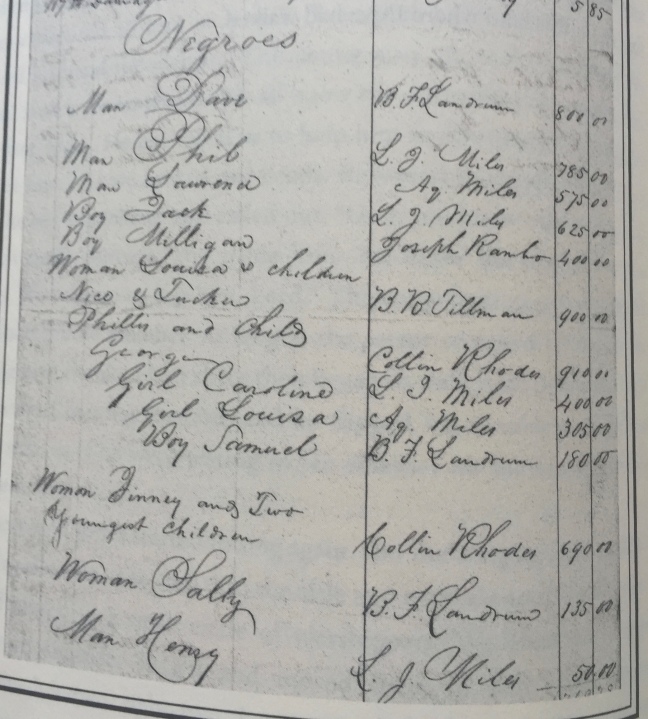
The end of the Civil War resulted in legal freedom for slaves, but many African American families remained separated. Set out to reunite, some reconstructed their broken family ties by forming kinship communities. Often, they would reinvent the definition of family based on their circumstances.(4)
Newly freedman also used slave-naming patterns. These were patterns that were purposely used in hopes that it would assist lost family members to identify family members and kin. They would commonly name children after their parents, grandparents, aunts, uncles and siblings.(5)
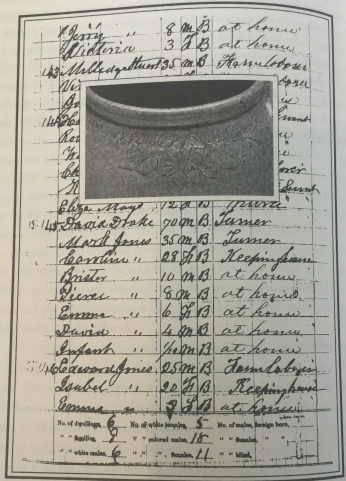
1870 United States Census, Shaws Creek, Edgefield County
Jill Koverman, discovered on the 1870 United States Census, that after the Civil War, Dave was listed as David Drake. (6)
Todd writes, “Soon after freedom came, what appears to be a kinship colony began to form around Dave…Dave is listed as David Drake, age seventy. He is shown living in the Shaws Creek section of Edgefield County just two houses away from the Miles family…Mark Jones, age thirty-five, is listed just after him in the same household. This is likely the potter Mark, whose name Dave is added beside his own on a 1859 jar. Caroline Jones, age twenty-eight, is listed next, followed by five Jones children: Brister, Pierce, Emma, David and an infant. ” (7)
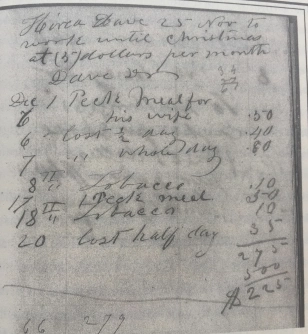
Lafayette Wever’s cash book listing Dave had purchased one peck of meal “for his wife.” 1866
I believe Caroline Jones was earlier listed on Rev John Landrum’s estate papers as “girl Caroline”. Many other scholars including myself, believe that she is most likely Dave’s daughter.
This is speculative but has some additional support. Another clue to this relationship is found on the death certificate of Caroline’s daughter, Emma Long. Her parents were recorded as: ” Mark Jones” from Charleston and “Caroline Miles” from Aiken, SC. (8) The surname Miles lines up with the “Girl Caroline” who was sold to Lewis J. Miles. This 1870 Census also shows us that Caroline named her third son David, another tie to Dave.
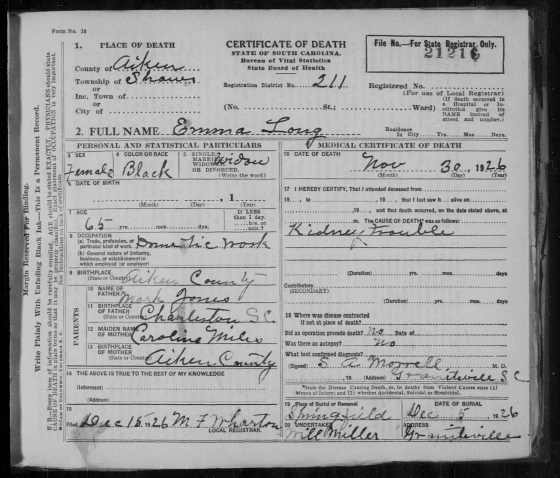
Dave’s connection and influence is also evident on a vessel made by Caroline’s son, Brister Jones. It is a beautiful pot standing about 16 inches tall with an inscription in the style of Dave. Leonard Todd suggests that this was a “kind of homage, Brister’s way of honoring the man who may well have been his grandfather.” (9)
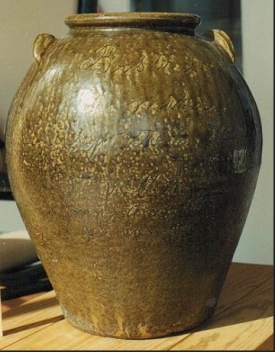
Jug made by Brister Jones -Sept 6, 1880
Brister Jones
The Maker
Sept the 6 1880
It Will hold
inny thing that
you can get in it
There have been a few people that feel there is not enough evidence to connect Dave and Caroline as possible kin and suggest rather, Dave may have held a mentorship/apprentice relationship with Mark Jones. It is important to note that prior to the 1870 census, slave ancestors had little records. If one was fortunate to have been listed in plantation records, or probate papers it was only by first name. Enslaved families were rarely recorded by birth, death or marriage and African-Americans researching their slavery roots only have a few clues in which to reconnect their family history. To expect them to hold to the same standard of proof with other ethnic groups that held direct evidence and whose immigration was voluntary, tend to take this for granted.
Tyler S. Haule, who lectures on the the topic of the GPS standard of geneology even stated, “Seasoned genealogists know that direct evidence records only last so long. At some point, all researchers face a situation where bits and pieces of indirect evidence is available, and when this happens, progress can hit a massive speed bump and careen to a halt. “Indirect evidence is like a puzzle piece,” continued Ison. “You can’t answer any particular question just based upon this piece of evidence. You have to fit it together.”
The process of exploring Dave’s family history was a moving and meaningful quest for me. Leonard had followed the line through each generation ending the family tree with Daisy Belle Jones born in 1906. (10) After a bit of digging, I was able to locate her obituary posted in Washington, D.C., providing me with another generation to follow.
After several phone calls, I finally heard the gentle voice of Daisy Whitner, whom I suspected was Dave’s great, great, great grand-daughter. We had a lengthy and exciting discussion about her great-grandparents, Pierce and Pauline, and other familiar family names.
She had never heard Dave’s name.
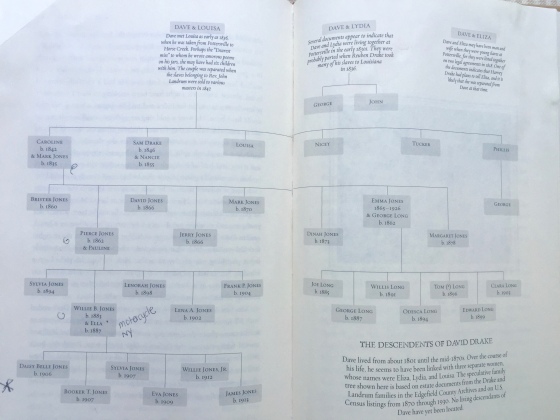
The Family Tree of David Drake by Leonard Todd in “Carolina Clay, The Life and Legend of the slave potter, Dave.”
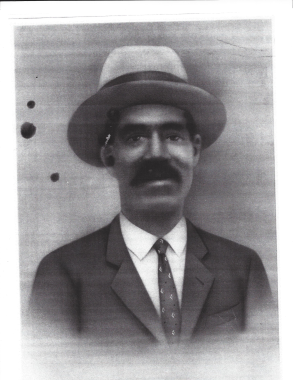
Pierce Jones, Grandson of Dave
I told her of Dave’s life and legacy, and the “great and noble jars” that are found in museums across the nation.
Daisy had been sitting comfortably in a chair and she now had stood up, amazed by Dave’s story.
Daisy and over thirty other family members of Pierce and Brister Jones drove from Washington D.C to meet us for the opening reception for Dave Day in Aiken.
There, we embraced, shed some tears and master potter Gary Dexter presented them with a marvelous face vessel that is a replica of one on display at the High Museum in Atlanta, that some researcher believe was fashioned by Dave. On the back, Gary inscribed one of Dave’s couplets written shortly after the Landrum slave sale in 1857:
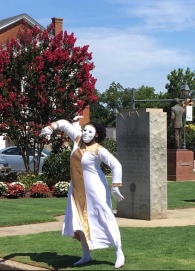
Njasi Oji, performing a praise dance from 2nd Providence Baptist Church
I wonder where is all my relation
friendship to all -and, every nation
The next day was a grand celebration in Edgefield. The square was bustling with music, mass choirs and local artisans. The film by Buddy Wingard and Mark Albertson, Discovering Dave; Spirit Captured in Clay was on view at the Tompkins Library.
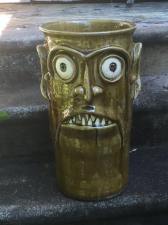
Face Vessel made by Gary Dexter
Later in the afternoon, almost two hundred people gathered at The Clay Studio for a program featuring Leonard Todd, historian Wayne O’Bryant, ceramics scholar, Arthur Goldberg, and myself. In addition, the audience was moved by the performances of the Geechee Gullah Ring shouters, who are all descendants of slaves brought from Africa.
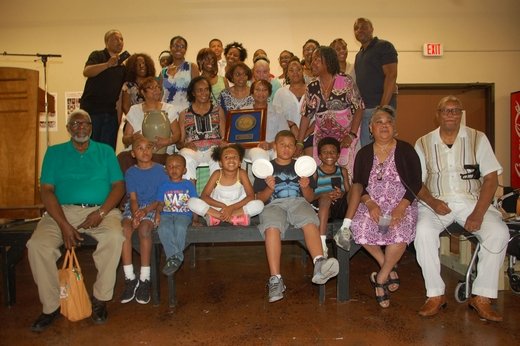
Staff photo courtesy of Dede Biles, Aiken Standard. The family of Dave the Potter, pose for a photograph holding a plaque from the Hall of fame and a tribute pot made by Justin Guy.
I read the words of Maya Angelou, “I am the gift my ancestors gave. I am the hope and the dream of the slave. I rise. I rise. I rise.”
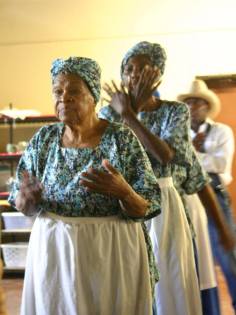 One by one, I called out names, and one by one, the family connected to David Drake stood up.
One by one, I called out names, and one by one, the family connected to David Drake stood up.
Some wiped tears from their eyes as they were introduced, while others stood smiling with great pride. The audience was equally moved. The four family elders came on to the stage to tell how excited they were about their connection to Dave and what it meant to them as a family. Master potter Justin Guy presented them with a special tribute jar that he had made in honor of Dave Day.
It was a magical day.
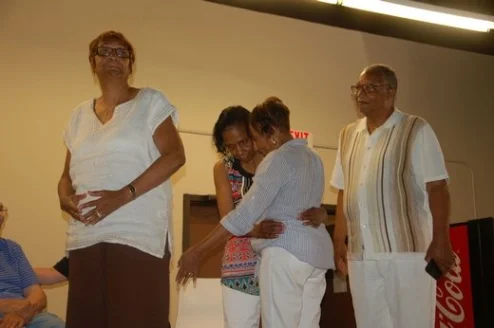
“This was most important day Edgefield has ever had,” said one woman to me later that evening. “This is so important to see us come together like this,” said another. The words on Wayne’s tee-shirt, “Live -United” reflected this. They parallel the words Dave penned more than a hundred- and- fifty years ago:
“Friendship to all.”
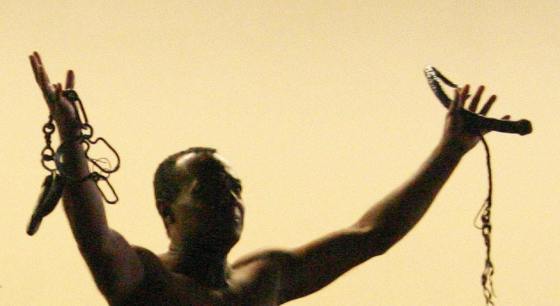
FOOTNOTES:
1 Ramona Austin, Yale University. Curator for the new Baron and Ellin Gordon Art Galleries at Old Dominion University. Interview with April L. Hynes August -2015
2 “Carolina Clay, the Life and Legend of the Slave Potter, Dave”, Leonard Todd pg 15
3 Estate of Rev John Landrum, Box 56, Pkg 2312, Probate Records, Edgefield County Archives.
4 Tristan L. Tolma, AG, The Effects of Slavery and Emancipation on African-American Families and Family History Research. Pg 1
5 “18 Negroes” Executor’s Sale, Edgefield Advertiser, February 3, 1847
6 (Berlin and Rowland, Families and Freedom, pg. 173) Berlin and Rowland, Families and Freedom, 8; Gutman, e Black Family in Slavery and Freedom, 190, 192, 195, 198–200. Gutman indicates that in naming children after their kin, slaves often displayed a preference for the maternal line. However, he also states that many slave sons were named for their fathers, perhaps because these children were more often separated from their fathers.
7 Jill Beute Koverman, editor. “I made this jar . . .” The Life and Works of the Enslaved African-American Potter, Dave. Columbia, S.C.: McKissick Museum, University of South Carolina, 1998.
8 “Carolina Clay, the Life and Legend of the Slave Potter Dave”, Leonard Todd pg. 162
9 Emma Long. Certificate of Death, November 30, 1926, Aiken County, South Carolina
10 “Carolina Clay, the Life and Legend of the Slave Potter, Dave”, Leonard Todd pg212

Absolutely Amazing